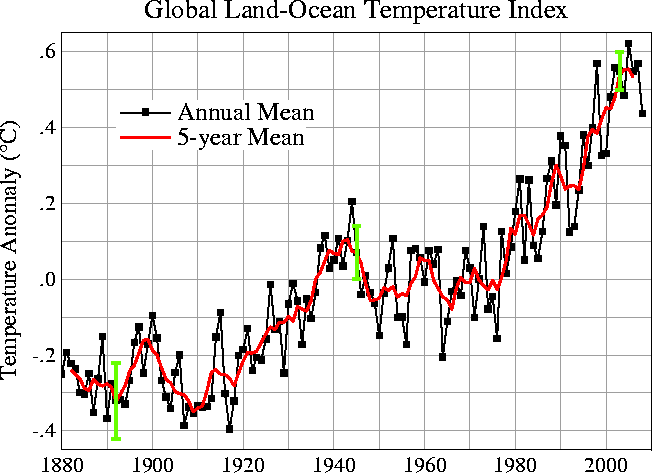Climate Feedback/Sensitivity
Climate Feedbacks: An interaction mechanism between processes in the climate system is called a climate feedback, when the result of an initial process triggers changes in a second process that in turn influences the initial one. A positive feedback intensifies the original process, and a negative feedback reduces it.
Climate feedbacks are processes that change as a result of a change in forcing, and cause additional climate change. An example of this is the “ice-albedo feedback.” As the atmosphere warms, sea ice will melt. Ice is highly reflective, while the underlying ocean surface is far less reflective. The darker ocean will absorb more heat, getting warmer and making the Earth warmer overall. A feedback that increases an initial warming is called a “positive feedback.” A feedback that reduces an initial warming is a “negative feedback.” The ice-albedo feedback is a very strong positive feedback that has been included in climate models since the 1970s.
Climate feedbacks are simply a resultant feedback of a change in the system that amplifies itself positively or negatively.
Fast & Slow Feedbacks
Since there are fast and slow feedbacks these all need to be studied in order to determine the expected amount of forcing from each and how these feedbacks affect each other. The major fast feedbacks are included in climate models. There is still much research to be done to include slow feedbacks and related effects.
The National Academy of Sciences, National Research Council, Board on Atmospheric Science and Climate Present:
‘Climate Change: Lines of Evidence’ – How Much Warming?
Here is how it works
If you increase CO2, CH4 and N20, then you induce warming:
- This warming of the atmosphere then warms the ocean.
- When the ocean warms it evaporates more H20 (a greenhouse gas)
- This traps more heat in the atmosphere.
Then,
- This warming of the atmosphere then warms the ocean.
- When the ocean warms it evaporates more H20 (a greenhouse gas)
- This traps more heat in the atmosphere.
and so on.
The risk we face from climate feedbacks are that if natural balance is not restored, the system may begin to amplify on its own without further inducement from human caused forcing.
While negative feedbacks can have an impact the current data and analysis indicates that the overall feedback effect will be positive. Very few scientists are arguing that the feedbacks may be more negative than currently indicated in the science. These claims have been examined and found not to fit the available data.
Other feedbacks include seasonal shift, latitudinal shift, changes in ice albedo and the carbon sink and many more. All these different feedbacks interact with each other in very complex ways which are becoming better understood through dedicated research to the subject. It is important to understand feedbacks in order to further quantify the risk factors and time scales involved with climate change.
Sensitivity (climate sensitivity)
Sensitivity is related to climate feedbacks and has to do with the amount of positive or negative forcing that occurs in response to a given climate forcing. In the natural cycle regarding long term natural climate change caused by Milankovitch cycles, at least for the past million years or so, the sensitivity response to changes is indicated to alter the global temperature by 6º Celsius between warm periods and glacial periods. Research indicates that this is initiated by relatively small changes in forcing and thus infers that climate sensitivity is stronger than the low end estimates that a very few scientists still believe plausible.
Links
- 2010/10 RealClimate: More on Feedbacks
- 2010/09 RealClimate: Introduction to Feedbacks
- 2005/04 RealClimate: Water Vapour Feedback or Forcing
- https://climate.nasa.gov/uncertainties/
- https://www.epa.gov/climatechange/glossary.html#ClimateFeedback
- https://www.ncdc.noaa.gov/oa/climate/gases.html
- 2006, March – Climate sensitivity: Plus ça change…
- 2004, November – Climate Sensitivity
- 2007, The CO2 Problem in 6 Easy Steps
Climate sensitivity:
- 11ºC warming, climate crisis in 10 years? (
 ) (
) ( )
) - Climate sensitivity and aerosol forcings
- Natural Variability and Climate Sensitivity
- Richard Lindzen’s HoL testimony
- Climate sensitivity: Plus ça change…
- Runaway tipping points of no return (
 ) (
) ( )
) - Climate Feedbacks
- The CO2 problem in 6 easy steps
- Climate Insensitivity
- The certainty of uncertainty
- Target CO2 (
 ) (
) ( )
) - Simple Question, Simple Answer… Not (
 ) (
) ( ) (
) ( ) (
) ( ) (
) ( )
)
- Related content
- Climate Forcing
- Greenhouse Gases/Effect
- Milankovitch Cycles

